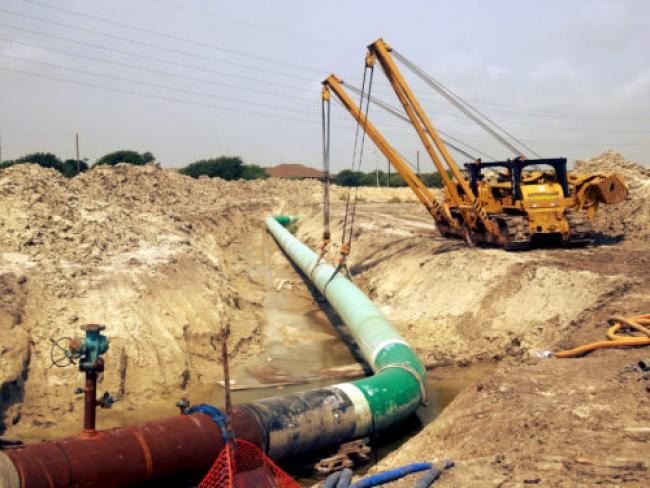Articles Menu

Jan. 6, 2022
The federal Crown corporation building the Trans Mountain Pipeline expansion has been handed a seven-day deadline to answer tough questions about soil stability, drilling method, and environmental impacts after proposing to redrill and reroute part of a 1.5-kilometre tunnel beneath the Fraser River, an iconic salmon-bearing waterway near the Lower Mainland population centre of Coquitlam.
In a notice yesterday to Trans Mountain legal representative Jeremy Barretto of Cassels Brock & Blackwell LLP, the Canadian Energy Regulator (CER) gave [PDF] Trans Mountain a January 13 deadline to respond to concerns filed by environmental campaigners, most of them associated with a coalition challenging the redrill request.
In a separate notice, the federal regulator asked [PDF] the company for a “detailed response” to the campaigners’ concerns about the “design and feasibility of the proposed revised route”, as well as the extent of its engagement with Indigenous communities in the area.
In a release this week, the Stop TMX coalition cites a “series of troubling incidents around this segment of the multi-billion-dollar project, all pointing to cost-cutting measures on risk management”. The coalition is calling for measures to maximize the safety of the crossing, including soil testing, extended casing to prevent spills of drilling fluids, a change in drilling method, and more detailed reporting of environmental releases.
The group also expresses concern about the risk of future pipeline failure as a result of an additional horizontal bend in the pipe.
Trans Mountain announced in late December that it must redrill 332 metres of the tunnel under construction, shifting the path about eight metres to the east. The announcement cited “mechanical failure” and “drill pipe failed” as TMX’s reasoning for the change. The coalition maintains the problem stems from a lack of soil testing along the route of the crossing, and the use of a drilling method known as horizontal direct drilling (HDD).
“Taken with the other issues at this location—sinkholes that threatened the lives of motorists; the release of a cubic metre of drilling fluid into the river—the announcement [implies] the application of trial and error and refreshes concerns about the risks of this project and its management,” the coalition release states. “In the case of this segment of the 1,150-kilometre new pipeline, the world’s greatest salmon-producing river is at risk.”
The coalition states that the choice of drilling method for crossings must be informed by a thorough analysis of soil structure, based on test bores and soil surveys. Multiple test bores were drilled on the route for the Thompson, North Thompson, and Clearwater River crossings. Test drilling on the Fraser was conducted between 2002 and 2009, but at locations 276 to 500 metres away, which the coalition says may not accurately reflect geophysical conditions along the actual route.
In feasibility reports submitted by Trans Mountain to the then National Energy Board in 2015, BCG Engineering expressed “considerable uncertainty” and recommended additional test bores at the Fraser River crossing. However, only one borehole was drilled in 2017, and it was located about 300 metres from the route, the coalition says.
A central issue is the decision by Trans Mountain to use horizontal direct drilling (for the Fraser River crossing. HDD is the least expensive method of trenchless construction. However, in 2015, Trans Mountain engineering consultant Hatch Scott MacDonald warned about hydraulic fracturing in the Coquitlam area and suggested the use of a technique called drilling intersect rather than HDD. Trans Mountain used yet another method, direct pipe, for its Clearwater River crossing, and plans to do the same for its Vedder River crossing this year.
In a 2018 report to Trans Mountain, Thurber Engineering advised that it was concerned about potential “geotechnical challenges” with the crossing. Thurber “strongly favoured” the use of the drilling intersect method, combined with casing on both sides of river.
Now, the coalition is calling for a micro-tunnel boring machine/direct pipe method of drilling, a “better solution to avoid more release of drilling fluid in the Fraser River.”
The proposed redrill includes the addition of 100 to 130 metres of casing, designed to protect the Mary Hill ByPass highway from settling and potential releases of drilling fluid. In November, the bypass on a highway ramp developed a sink hole, which the coalition attributes to pipeline tunnel collapse but Trans Mountain blames on heavy rainfalls. The coalition wants extended casing under the river to prevent future releases.
A company spokesperson told Tri City News the change in route is a “minor deviation” that is “necessary to mitigate challenges with the current path.” The email added that “our construction methods for the Fraser River HDD have been reviewed and approved by the [Canadian Energy Regulator],” and “preconstruction subsurface investigations align with conditions encountered during construction.”
But coalition spokesperson Peter Vranjkovic countered that “testing and investment in a river crossing of such high stakes has been wholly inadequate,” with the result that “the world’s greatest salmon producing river is at risk.”
He added that the pipeline makes no sense environmentally, “but if you’re going to do it, do it safely.”
Coalition member organizations include Protect the Planet/Stop TMX, Mountain Protectors, Protect the Inlet, Extinction Rebellion Vancouver, STAND.Earth, Burnaby Residents Opposing Kinder Morgan Expansion (BROKE), Climate Convergence, Dogwood, Colony Farms Regional Park, Babies for Climate Justice, Sustainabiliteens Vancouver, 350 Vancouver, 350 SFU, and the Wilderness Committee.
[Top photo: Jay Phagan/Flickr]